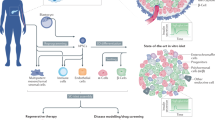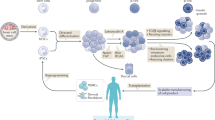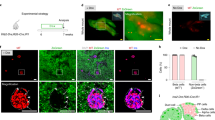Abstract
Replacing missing insulin-producing β cells to treat diabetes is a major challenge for regenerative medicine. A better understanding of β-cell embryogenesis and regeneration in adult life is needed to devise means to derive these specialized cells in sufficiently large numbers from stem or precursor cells. It is also critical to ensure that any surrogate or regenerated β cells have perfectly regulated insulin production, which is essential for physiological glucose homeostasis.
This is a preview of subscription content, access via your institution
Access options
Subscribe to this journal
Receive 12 print issues and online access
$209.00 per year
only $17.42 per issue
Buy this article
- Purchase on Springer Link
- Instant access to full article PDF
Prices may be subject to local taxes which are calculated during checkout


Similar content being viewed by others
References
Knight, J. Biologists fear cloning hype will undermine stem-cell research. Nature 430, 817 (2004).
Donath, M. Y. & Halban, P. A. Decreased β-cell mass in diabetes: Significance, mechanisms and therapeutic implications. Diabetologia 47, 581–589 (2004).
Edlund, H. Organogenesis: Pancreatic organogenesis developmental mechanisms and implications for therapy. Nature Rev. Genet. 3, 524–532 (2002).
Murtaugh, L. C. & Melton, D. A. Genes, signals, and lineages in pancreas development. Annu. Rev. Cell Dev. Biol. 19, 71–89 (2003).
Stoffel, M., Vallier, L. & Pedersen, R. A. Navigating the pathway from embryonic stem cells to β cells. Semin. Cell Dev. Biol. 15, 327–336 (2004).
Colman, A. Making new β cells from stem cells. Semin. Cell Dev. Biol. 15, 337–345 (2004).
Leon-Quinto, T., Jones, J., Skoudy, A., Burcin, M. & Soria, B. In vitro directed differentiation of mouse embryonic stem cells into insulin-producing cells. Diabetologia 47, 1442–1451 (2004).
Hellerstrom, C., Andersson, A. & Gunnarsson, R. Regeneration of islet cells. Acta Endocrinol. Suppl. (Copenh.) 205, 145–160 (1976).
Bonner-Weir, S. Perspective: Postnatal pancreatic β cell growth. Endocrinology 141, 1926–1929 (2000).
Butler, A. E. et al. β-cell deficit and increased β-cell apoptosis in humans with type 2 diabetes. Diabetes 52, 102–110 (2003).
Bonner-Weir, S. Life and death of the pancreatic β cells. Trends Endocrinol. Metab. 11, 375–378 (2000).
Bonner-Weir, S. & Sharma, A. Pancreatic stem cells. J. Pathol. 197, 519–526 (2002).
Ianus, A., Holz, G. G., Theise, N. D. & Hussain, M. A. In vivo derivation of glucose-competent pancreatic endocrine cells from bone marrow without evidence of cell fusion. J. Clin. Invest. 111, 843–850 (2003).
Kojima, H. et al. Extrapancreatic insulin-producing cells in multiple organs in diabetes. Proc. Natl Acad. Sci. USA 101, 2458–2463 (2004).
Lechner, A. et al. No evidence for significant transdifferentiation of bone marrow into pancreatic β-cells in vivo. Diabetes 53, 616–623 (2004).
Hess, D. et al. Bone marrow-derived stem cells initiate pancreatic regeneration. Nature Biotechnol. 21, 763–770 (2003).
Dor, Y., Brown, J., Martinez, O. I. & Melton, D. A. Adult pancreatic β-cells are formed by self-duplication rather than stem-cell differentiation. Nature 429, 41–46 (2004).
Seaberg, R. M. et al. Clonal identification of multipotent precursors from adult mouse pancreas that generate neural and pancreatic lineages. Nature Biotechnol. 22, 1115–1124 (2004).
Bouwens, L. & Pipeleers, D. G. Extra-insular β cells associated with ductules are frequent in adult human pancreas. Diabetologia 41, 629–633 (1998).
Bonner-Weir, S. et al. In vitro cultivation of human islets from expanded ductal tissue. Proc. Natl Acad. Sci. USA 97, 7999–8004 (2000).
Gao, R. et al. Characterization of endocrine progenitor cells and critical factors for their differentiation in human adult pancreatic cell culture. Diabetes 52, 2007–2015 (2003).
Heremans, Y. et al. Recapitulation of embryonic neuroendocrine differentiation in adult human pancreatic duct cells expressing neurogenin 3. J. Cell Biol. 159, 303–312 (2002).
Ferber, S. et al. Pancreatic and duodenal homeobox gene 1 induces expression of insulin genes in liver and ameliorates streptozotocin-induced hyperglycemia. Nature Med. 6, 568–572 (2000).
Zalzman, M. et al. Reversal of hyperglycemia in mice by using human expandable insulin-producing cells differentiated from fetal liver progenitor cells. Proc. Natl Acad. Sci. USA 100, 7253–7258 (2003).
Kahn, S. E. Engineering a new β-cell: A critical venture requiring special attention to constantly changing physiological needs. Semin. Cell Dev. Biol. 15, 359–370 (2004).
Halban, P. A., Kahn, S. E., Lernmark, A. & Rhodes, C. J. Gene and cell-replacement therapy in the treatment of type 1 diabetes: How high must the standards be set? Diabetes 50, 2181–2191 (2001).
Orci, L. Macro and micro-domains in the endocrine pancreas. Diabetes 31, 538–565 (1982).
Weir, G. C. Can we make surrogate β-cells better than the original? Semin. Cell Dev. Biol. 15, 347–357 (2004).
Howell, S. L. The mechanism of insulin secretion. Diabetologia 26, 319–327 (1984).
Acknowledgements
P.A.H. is supported by the Juvenile Diabetes Research Foundation, the National Institutes of Health and the Swiss National Science Foundation.
Author information
Authors and Affiliations
Rights and permissions
About this article
Cite this article
Halban, P. Cellular sources of new pancreatic β cells and therapeutic implications for regenerative medicine. Nat Cell Biol 6, 1021–1025 (2004). https://doi.org/10.1038/ncb1104-1021
Issue Date:
DOI: https://doi.org/10.1038/ncb1104-1021
This article is cited by
-
Angiopoietins stimulate pancreatic islet development from stem cells
Scientific Reports (2021)
-
IGF-I mediates regeneration of endocrine pancreas by increasing beta cell replication through cell cycle protein modulation in mice
Diabetologia (2008)
-
Pluripotency of embryonic stem cells
Cell and Tissue Research (2008)
-
Beta-cell differentiation from nonendocrine epithelial cells of the adult human pancreas
Nature Medicine (2006)
-
Increased islet beta cell replication adjacent to intrapancreatic gastrinomas in humans
Diabetologia (2006)



